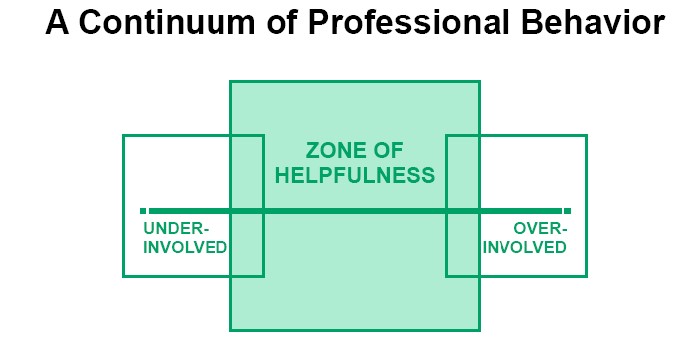My professional boundaries as a trainer – introduction
Setting professional boundaries as a trainer helps to assure professionalism and quality of work with individuals. Professional boundaries are an internal compass which helps us to understand how to behave in a difficult training situation or individual interventions with participants. Placing professional boundaries in the team by the trainer will help to avoid conflicts and act as a team in difficult situations.

Why did I choose this tool?
This tool will help you to understand the basic elements of trainers’ professional boundaries and help you to make personal guidelines on how to deal with different situations with participants. The professional boundaries are helpful to avoid over involvement and burn out.
How does this apply to being a trainer?
Professional boundaries help you to better understand your role as a trainer. These ethical principles of behaviour help to avoid mistakes that trainers – beginners tend to make. These principles allow you to easier disconnect from the group processes and prepare yourself for new educational activities. The principles help the teams of trainers to develop a common understanding of what kind of relationships the trainers team has with the participants and when and how to support a colleague trainer in a challenging situation.
Main content:
- Step: Read through the key points to introduce the concept of professional boundaries in training

Description of the scheme:
The zone of helpfulness is in the centre of the professional behaviour continuum. This zone is where the majority of trainer-participant interactions should occur. Over-involvement with a participant is on the right side of the continuum – this includes boundary crossing and boundary violations. Under-involvement lies on the left side – this includes distancing, disinterest and neglect. There are no definite lines separating the zone of helpfulness.
What Are Professional Boundaries in the training field?
- Clearly established limits that allow safe connections between trainers and their participants;
- “Being with” participants, not becoming one of the participants;
- Being friendly, not friends;
- A clear understanding of the limits and responsibilities in your role as a trainer.
The Importance of Professional Boundaries in Training
- Role modelling to participants’ healthy communication and professional relationships;
- Avoiding the “rescuer” role;
- Staying focused on one’s responsibilities to the participants & the provision of helpful and appropriate educational activities to the participants;
- Avoiding burn-out (“compassion fatigue”);
- Maintaining a healthy, open, communicating and functioning team, when working in conjunction with other trainers or specialists.
- Maintaining one’s physical and emotional safety.
Consequences of Having Loose/Poor Professional Boundaries:
- Compassion fatigue – the trainers’ role may not feel sustainable;
- Participants may not be given quality training services, which could affect his/her willingness to accept future services;
- Participants may feel poorly served, or feel the lack of professionalism of the trainer;
- The trainer may act unethically;
- The reputation of the trainer, the institution or being a trainer as a profession may be compromised.
- The trainer and/or the participant may be emotionally traumatized and/or put in physical danger.
Why Is It Difficult to Establish and Maintain Professional Boundaries?
- Dual relationships – The trainer & participant know each other at professional and personal level, also from other setting.
- Conflict of values – The participants’ choices, history, relationships, feelings, lifestyle and/or life circumstances conflict with the trainers’ values and/or knowledge about the theme and the practices.
- Vicarious trauma – The trainer experiences trauma symptoms from hearing about the participants’ experiences. The trainer may be triggered due to having a history of similar circumstances.
- Playing the “hero” role – The trainer feels the need to “save” the participant.
- Poor teamwork – The trainer doesn’t believe that other team members are fulfilling their responsibilities to the participants, and believes that he/she can provide their services better, and/or believes that the participants will learn best with him/her. The trainer takes over the roles of the other team members.
Signs that Boundary Issues May Be Present Between the Service Provider and the Client
- The participant and the trainer begin referring to each other as friends;
- The participant is asking significant personal information from the trainer;
- The participant asks/expects from the trainer to socialize with him/her outside of the professional setting (e.g., to be the last one to leave the party with participants);
- The trainer reveals excessive personal information to the participant;
- The trainer is unable to sleep due to anxiety related to the participants’ personal situation or story;
- The trainer offers to provide assistance to the participant outside of his/her role (e.g., things not linked to the topic of the training);
- The trainer finds him/herself “ventilating” (gossiping) with other participants about other team members.
- Make a personal list of “10 – not to do” as a trainer in the interaction with the participants. Define your personal professional boundaries as a trainer.
Reflection questions:
Remember 5 situations from the training courses (as a participant or as a trainer) when you observed or took part in overstepping professional boundaries?
Reflect what kind of emotions were you feeling while observing the overstepping of professional boundaries.
Which 3 personal rules you would not break in training situations.






